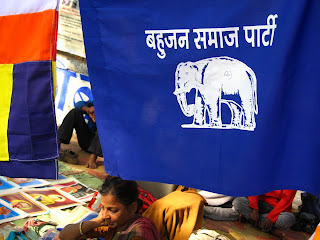
 My seven weeks thus far on the subcontinent have brought me into close proximity with more human beings than I have ever seen, smelled, or touched. This India is teeming with bodies. More than anything else, what differentiates one's experiences with the Indian masses from experiences with masses of people in other countries is the extent to which the Indian masses are so severely downtrodden. The Britishers used to call these folks the depressed classes of Indian society.
My seven weeks thus far on the subcontinent have brought me into close proximity with more human beings than I have ever seen, smelled, or touched. This India is teeming with bodies. More than anything else, what differentiates one's experiences with the Indian masses from experiences with masses of people in other countries is the extent to which the Indian masses are so severely downtrodden. The Britishers used to call these folks the depressed classes of Indian society. At times, they have been labeled backwards, indigent, or primitive. While those who formerly were considered untouchables constitute about 16% of India's population, around 2/3 of the country's inhabitants are considered backwards. This term is not considered offensive or even politically incorrect here. It is not suggestive of one's political inclination or ideological bent. Dalit is the term used for "broken" people, and although it is generally limited to those who are termed Scheduled Castes (former untouchables), it is a word that encompasses a much broader movement and a much larger amalgamation of downtrodden groups. So, I believe that it can be effectively applied to the better portion of this country's people. This would include all of the originally low-caste people who currently self-identify with either Hinduism or any of the other various faiths that have absorbed large numbers of former untouchables.


Either way, I must first make clear that I have no intention of presenting my political views herein. Due to the nature of my research activities in Mumbai, I refrain from political participation to the best of my ability. While this is difficult to do when researching Dalit issues, it is necessary to do so in order to present impartial findings on the subject after fair evaluation of sources, scope, and eventual utilization of resource outputs after the project's completion.
So, regardless of political orientation, all those who understand India's workings realize that the vast majority of her people are struggling, impoverished, and lacking in material resources. I offer no assessment of whether such material dearth is better or worse for satisfaction levels over the course of a lifetime.
Over the past few weeks, I've had the opportunity to observe many aspects of the Indian social structure. While studying the various forms of cultural organization that keep Indian society severely stratified, I have embarked on a mission to document and describe, understand and enlighten. I do my best to maintain neutrality, and I avoid political engagement. Perhaps some folks see that this is not even possible given the nature of social science and human geography research. But, my goal is certainly to maintain as unbiased a stance as possible.


That being said, I have observed whom some may refer to as the dregs of the earth. Dalits are the throngs of human beings that arouse feelings of insecurity in those who fear overpopulation with masses of uneducated, un-Westernized, and unchanged persons. These folks have not much evolved due to how they have been disconnected from many possible channels to advancement. Yet, opportunities exist that may be availed by these populations.
Despite their hunger and pain, their madness and degradation, these are pure human beings. Gandhi called them children of God: Harijans. They are beautiful despite their ignorance and seemingly permanent state of severe defeat. They are emerging. They swear never to remain broken, devalued, downtrodden.
One caste/one tribe. One earth/one love.






No comments:
Post a Comment